

Chimp 'Police' Keep Peace Among Apes, Primate Researchers Say. By: Charles Choi, LiveScience Contributor Published: 03/07/2012 05:16 PM EST on LiveScience Chimpanzees have police, too.
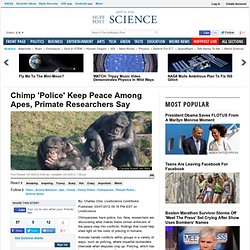
Archaeoacoustics: Tantalizing, But Fantastical. In Ancient Ore. Dump, Clues To The First Americans? Hide captionDisplayed in the hand of University of Oregon archaeologist Dennis Jenkins are three bases for western stemmed projectiles from the Paisley Caves in Oregon.
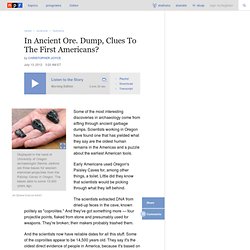
The bases date to some 13,000 years ago. Jim Barlow/Science/AAAS. Oceans Set Stage For Human Evolution. Was human evolution caused by climate change? According to a paper published in Science, models of how animal and plant distributions are affected by climate change may also explain aspects of human evolution.

The approach takes existing knowledge of the geographical spread of other species through the warming and cooling of the ice ages to provide a model that can be applied to human origins. "No one has applied this knowledge to humans before," said Dr John Stewart, lead author on the paper and researcher at Bournemouth University. "We have tried to explain much of what we know about humans, including the evolution and extinction of Neanderthals and the Denisovans (a newly discovered group from Siberia), as well as how they interbred with the earliest modern populations who had just left Africa. All these phenomena have been put into the context of how animals and plants react to climate change.
Ancient seagrass: 'Oldest living thing on earth' discovered in Mediterranean Sea. New Ancestor Grasped At Walking. The real caveman diet: What did people eat in prehistoric times? Janek Skarzynski/AFP/Getty Images.

Russian scientists claim to have grown a plant from the fruit of an arctic flower that froze 32,000 years ago in the Arctic. That’s about the same time the last Neanderthals roamed the Earth. This particular plant doesn't produce an edible fruit analogous to an apple or nectarine, but rather a dry capsule that holds its seeds. Did hominids eat fruits and veggies during the Neanderthal era? They definitely ate fruit. Vegetables are a different story. It’s not altogether clear why fruits have changed less than vegetables, but it might have something to do with their evolutionary purpose. Just because there are some paleolithic fruits in production today doesn’t mean you can easily mimic the paleolithic diet. Got a question about today’s news?
Earliest Known Human Relatives Came from Asia. - A new fossil primate, Afrasia, is related to, but more primitive than, an early African primate from Libya. - The find strengthens the belief that anthropoids originated in Asia. - Afrasia and other Asian anthropoids likely migrated to Africa 37-38 million years ago.
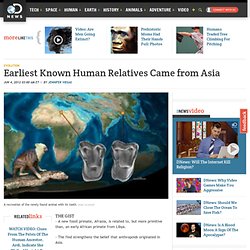
The ancestors of humans, apes and monkeys evolved first in Asia before moving on to Africa, suggests a new fossil find from Myanmar. Ancient North Africans Got Milk. Does the African genome hold the secrets of a previously unknown species of hominid? Sunday Morning Bobblehead Thread. Slacker Rat, Worker Rat. Domestication of Felines" In sharp contrast to dogs, cats did not evolve to look or act very different from their wild ancestors.

This fact has made it difficult for scientists to determine when exactly cats domesticated. Although evidence shows that cats probably did not evolve from modern large cats, such as lions and tigers, Archaeologists cannot use the shapes of old bones and scientists cannot investigate DNA to distinguish between ancient small wild cats and modern domesticated cats. However, some evidence does lead scientists to believe that the modern domestic cat (Felus catus) may have descended from a European wild cat (Felis silvestris) and an African wild cat (Felis lybica), cats that still exist in the wild. Other clues provide some convincing evidence about early feline domestication. Calcium Offers Clues In Mass Extinction. Unearthing the cause of mass extinction. The structures look like big volcanoes.

This is a photo of Caledra of Askja volcano in Iceland. (Photo: Wikipedia Commons) Chris Smith from the Naked Scientists, a British science radio show, recently spent some days in Oslo interviewing Norwegian scientists. Founder effect. Simple illustration of founder effect.
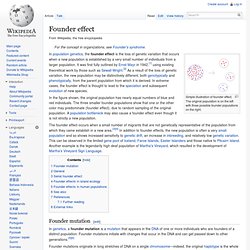
The original population is on the left with three possible founder populations on the right. In population genetics, the founder effect is the loss of genetic variation that occurs when a new population is established by a very small number of individuals from a larger population. What Vikings really looked like. The fine decoration of the Oseberg ship in Norway, which was buried in the year 834, provides clues to what Vikings looked like.
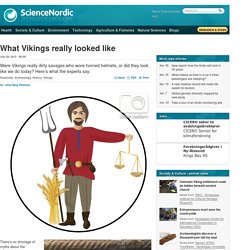
Inside the ship were two women and the archaeologists believe the ship has served as a sarcophagus. (Photo: Annie Dalbéra) There’s no shortage of myths about the appearance of our notorious Viking ancestors. To find out more about these myths, ScienceNordic’s Danish partner site, videnskab.dk, asked its Facebook readers to list their favourite myths about what the Vikings looked like. We have picked out five myths from the resulting debate and asked researchers to help us confirm or bust these myths. Mystical marks in virgin forest explained. Patches of bark have been removed from older pines in the Øvre Dividalen National Park, but not in ways that would prevent the trees from continuing to grow.
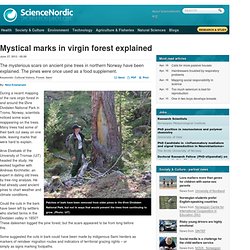
(Photo: UiT) During a recent mapping of the rare virgin forest in and around the Øvre Dividalen National Park in Troms, Norway, scientists noticed some scars reappearing on the trees. Many trees had some of their bark cut away on one side, leaving marks that were hard to explain. Where's the Beef? Early Humans Took It. PALISADES, NEW YORK—When human ancestors began scavenging for meat regularly on the open plains of Africa about 2.5 million years ago, they apparently took more than their fair share of flesh.
Within a million years, most of the large carnivores in the region—from saber-toothed cats to bear-size otters—had gone extinct, leaving just a few "hypercarnivores" alive, according to a study presented here last week at a workshop on climate change and human evolution at Columbia University's Lamont-Doherty Earth Observatory. Humans have driven thousands of species extinct over the millennia, ranging from moas—giant, flightless birds that lived in New Zealand—to most lemurs in Madagascar. But just when we began to have such a major impact is less clear.
Researchers have long known that many African carnivores died out by 1.5 million years ago, and they blamed our ancestor, Homo erectus, for overhunting with its new stone tools. Preface: Theory of Evolution. Theories of Evolution The idea of evolution is of great antiquity. Empedocles, around 440 BC, wrote that there were once "countless tribes of mortal creatures, scattered abroad and endowed with all manner of forms," which united as chance permitted, with some combinations surviving, others not.
For Empedocles, Chance and Necessity governed the world. Aristotle, 200 years later, rejected the possibility, arguing that the creatures each had a given form or nature. Meteorite Crater In Greenland Called World's Oldest, Biggest. 500 Million-Year-Old 'Mistake' Led to Humans. - A genetic process that went wrong 500 million years ago led to the evolution of humans and other vertebrates. - The event, which resulted in doublings of genes, also led to proteins responsible for many of today's diseases. - Studying these proteins could help researchers learn more about human evolution and the inner workings of diseases.
Mankind's remotest relative is the protozoan. Genetic analyses of a micro-organism that lives in the sludge of a lake in Ås, 30 km south of Oslo i Norway, are providing researchers with an insight into what the first life on Earth looked like. (Photo: UiO/MERG) Biologists all over the world have been eagerly awaiting the results of the genetic analysis of one of the world's smallest known species, called the protozoan, from a little lake 30 kilometer south of Oslo in Norway. When researchers from the University of Oslo compared its genes with all other known species in the world, they saw that the protozoan did not fit on any of the main branches of the tree of life. The protozoan is not a fungus, alga, parasite, plant or animal. "We have found an unknown branch of the tree of life that lives in this lake. World's oldest creature Life on Earth can be divided up into two main groups of species, prokaryotes and eukaryotes.
Oldest Modern Human Bones Ever Found In Asia Help Settle Debate Over Human Migration. By: Charles Choi, LiveScience Contributor Published: 08/20/2012 03:14 PM EDT on LiveScience. Human Ancestors Were Nearly All Vegetarians. 'Britain's Atlantis' found at bottom of North sea - a huge undersea kingdom swamped by a tsunami 5,500 years ago. Legendary Viking town unearthed. The excavation work is mainly carried out by young archaeologists.